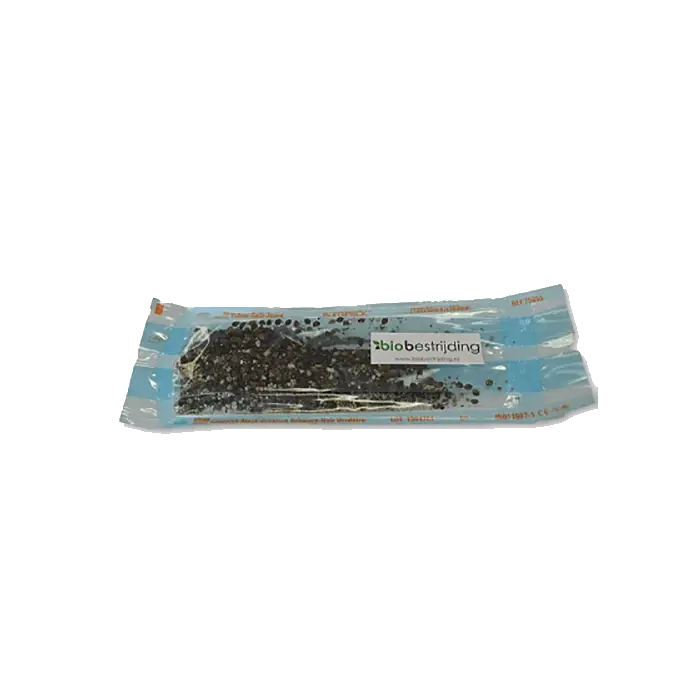BioBestrijding | Predatory Mite against Thrips Preventive ~ Hypoaspis Miles
BioBestrijding Control Predatory Mite against Thrips Preventive
Attention! This product consists of live animals and is only available for order in the Netherlands or Belgium. If you order more than just Bio Fight, there will be an additional charge of € 7.95 due to dropshipping from the supplier.
For a preventive control of thrips, we supply the Hypoaspis miles (Stratiolaelaps scimitus) predatory mite. The Hypoaspis miles is a soil-dwelling predatory mite that controls a wide range of insects. In particular, it controls thrips pupae and larvae, but also other insects such as larvae and pupae of sciarid flies, straw mites, bulb mites, springtails, blood lice and the larvae of the moth Duponchelia. This predatory mite lives in the upper soil layer up to 4 cm deep and can move quickly through the soil layer and feels at home in moist (potting) soil.
Because the Hypoaspis targets the eggs and young thrips in the soil and not the adult thrips, the Hypoaspis is especially suitable as a preventative against thrips. Do you want a solution against the present, adult thrips? Then you need the Orius predatory bugs. It is advisable to introduce the Hypoaspis together with the Orius for a total control.
Way of life Hypoaspis Miles
An adult Hypoaspis predatory mite lives for about 6 weeks and is active at temperatures of 10C to 28C. The sex ratio is equal to 1:1, females and males. If there is enough to eat, the females lay eggs frequently. The eggs hatch within 2-3 days and the young Hypoaspis nymphs are born. These young nymphs are fierce predators immediately after birth, consuming eggs and small thrips larvae. Each adult Stratiolaelaps can consume 1 to 5 prey per day. The Hypoaspis population can also survive in the absence of pests. In this case, they feed on algae and plant debris. However, if necessary, the Hypoaspis miles population can also go up to 7 weeks without food by going into a resting phase.
How many predatory mites do you need?
These predatory mites are delivered in a package with scatter material containing eggs, young and adult predatory mites. A package with 2500 predatory mites is sufficient for about 10 square meters depending on how much you suffer from thrips. We generally recommend 250 to 500 predatory mites per square meter. After one to two weeks it is good to give a maintenance dosage of another 250 pieces per square meter. If thrips are already present you can choose to increase the dose to 500 pieces per square meter.
Air humidity and temperature
Optimal humidity is between 60% and 70%. The Hypoaspis predatory mites are active from 10 degrees but only come into action at a soil temperature of 15 degrees. The optimum temperature is between 20 and 30 degrees. 26 degrees is the most ideal for the development.
Instructions
- Introduce Hypoaspis miles preventively or as soon as possible after the first appearance of thrips.
- Upon receipt, release as soon as possible, predatory mites are not durable.
- Open the bag containing the litter and predatory mites. Spread the material evenly over the (slightly) damp soil/ground of the plants.
- It is advisable to leave the package in the room for a few days so that the eggs and predatory mites that are left behind have a chance to develop.
Combination of Orius and Hypoaspis for a total thrips control
For an optimal control of thrips we recommend to introduce the Orius predatory bug in combination with the Hypoaspis predatory mite. Where Orius focuses on nymphs and adult thrips, the Hypoaspis predatory mite focuses mainly on the eggs and nymphs in the soil. These 2 predators combined provide a total control of thrips.
Storage advice
Biological beneficials are living animals and have a (very) short lifespan and should therefore be introduced as soon as possible after receipt. Storage can negatively influence the quality and is only possible under the conditions mentioned below.
- Storage life: 1-2 days
- Storage temperature: 8-10C
- Store in the dark and flat




